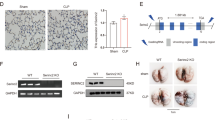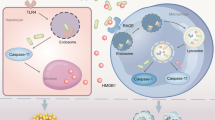Abstract
Background
High-mobility group box chromosomal protein 1 (HMGB1) has recently been shown to be an important late mediator of endotoxin shock, intraabdominal sepsis, and acute lung injury, and a promising therapeutic target of severe sepsis. We sought to investigate the effect of antibodies to HMGB1 on severe sepsis in a rat cecal ligation and puncture (CLP) model.
Methods
Adult male Sprague-Dawley rats underwent CLP and then were randomly divided into two groups: treatment with anti-HMGB1 polyclonal antibodies, and non-immune IgG-treated controls. The serum HMGB1 concentrations were measured at ten time points (preoperatively, and postoperatively at 4, 8, 20, 32, and 48 h and at 3, 4, 5, and 6 days). Hematoxylin-eosin staining, elastica-Masson staining, and immunohistochemical staining for HMGB1 were performed on the cecum and the lung to assess pathological changes 24 h after the CLP procedure.
Results
Treatment with anti-HMGB1 antibodies significantly increased survival [55% (anti-HMGB1) vs. 9% (controls); P< 0.01]. The serum HMGB1 concentrations at postoperative hours 20 and 32 of the anti-HMGB1 antibody-treated animals were significantly lower than those of the controls (P < 0.05). Treatment with anti-HMGB1 antibodies markedly diminished the pathological changes and the number of HMGB1-positive cells in the cecum and the lung.
Conclusions
The present study demonstrates that anti-HMGB1 antibodies are effective in the treatment of severe sepsis in a rat model, thereby supporting the relevance of HMGB1 eradication therapy for severe sepsis.





Similar content being viewed by others
References
Wang H, Bloom O, Zhang M, et al. HMG-1 as a late mediator of endotoxin lethality in mice. Science 1999;285:248–251
Abraham E, Arcaroli J, Carmody A, et al. Cutting edge: HMG-1 as a mediator of acute lung inflammation. J Immunol 2000;165:2950–2954
Wang H, Yang H, Tracey KJ. Extracellular role of HMGB1 in inflammation and sepsis. J Intern Med 2004;255:320–331
Ueno H, Matsuda T, Hashimoto S, et al. Contributions of high mobility group box protein in experimental and clinical acute lung injury. Am J Respir Crit Care Med 2004;170:1310–1316
Wichterman KA, Baue AE, Chaudry IH. Sepsis and septic shock—a review of laboratory models and a proposal. J Surg Res 1980;29:189–201
Baker CC, Chaudry IH, Gaines HO, et al. Evaluation of factors affecting mortality rate after sepsis in a murine cecal ligation and puncture model. Surgery 1983;94:331–335
Anton EO, Quintela AG, Soto AL, et al. Cecal ligation and puncture as a model of sepsis in the rat: influence of the puncture size on mortality, bacteremia, endotoxemia and tumor necrosis factor alpha levels. Eur Surg Res 2001;33:77–79
Heuer JG, Bailey DL, Sharma GR, et al. Cecal ligation and puncture with total parenteral nutrition: a clinically relevant model of the metabolic, hormonal, and inflammatory dysfunction associated with critical illness. J Surg Res 2004;121:178–186
Andersson U, Tracey KJ. HMGB1 in sepsis. Scand J Infect Dis 2003;35:577–584
Muller S, Ronfani L, Bianchi ME. Regulated expression and subcellular localization of HMGB1, a chromatin protein with a cytokine function. J Intern Med 2004;255:332–343
Querini PR, Capobianco A, Scaffidi P, et al. HMGB1 is an endogenous immune adjuvant released by necrotic cells. EMBO Rep 2004;5:825–830
Yang H, Ochani M, Li J, et al. Reversing established sepsis with antagonists of endogenous high-mobility group box 1. Proc Natl Acad Sci USA 2004;101:296–301
Jensenius JC, Andersen I, Hau J, et al. Eggs: conveniently packaged antibodies. Methods for purification of yolk IgG. J Immunol Methods 1981;46:63–68
Abeyama K, Stern DM, Ito Y, et al. The N-terminal domain of thrombomodulin sequesters high-mobility group-B1 protein, a novel anti-inflammatory mechanism. J Clin Invest 2005;115:1267–1274
Yamada S, Inoue K, Yakabe K, et al. High mobility group protein 1 (HMGB1) quantified by ELISA with a monoclonal antibody that does not cross-react with HMGB2. Clin Chem 2003;49:1535–1537
Naito Z, Ishiwata T, Kurban G, et al. Expression and accumulation of lumican protein in uterine cervical cancer cells at the periphery of cancer nests. Int J Oncol 2002;20:943–948
Glyn E, Evans V, Sigurgeirsson B. Double blind, randomised study of continuous terbinafine compared with intermittent itraconazole in treatment of toenail onychomycosis. BMJ 1999;318:1031–1035
Suda K, Kitagawa Y, Ozawa S, et al. Serum concentrations of high-mobility group box chromosomal protein 1 before and after exposure to the surgical stress of thoracic esophagectomy: a predictor of clinical course after surgery? Dis Esophagus 2006;19:5–9
Ono S, Aosasa S, Mochizuki H. Effects of a protease inhibitor on reduction of surgical stress in esophagectomy. Am J Surg 1999;177:78–82
Sato N, Koeda K, Ikeda K, et al. Randomized study of the benefits of preoperative corticosteroid administration on the postoperative morbidity and cytokine response in patients undergoing surgery for esophageal cancer. Ann Surg 2002;236:184–190
Sato N, Endo S, Kimura Y, et al. Influence of a Human Protease inhibitor on surgical stress induced immunosuppression. Dig Surg 2002;19:300–305
Watanabe T, Kubota S, Nagaya M, et al. The role of HMGB-1 on the development of necrosis during hepatic ischemia and hepatic ischemia/reperfusion injury in mice. J Surg Res 2005;124:59–66
Czura CJ, Yang H, Tracey KJ. High mobility group box-1 as a therapeutic target downstream tumor necrosis factor. J Infect Dis 2003;187:S391–S396
Mitchell BR, Ochani M, Li J, et al. IFN-γ induces high mobility group box 1 protein release partly through a TNF-dependent mechanism. J Immunol 2003;170:3890–3897
Yang H, Wang H, Tracey KJ. HMG-1 rediscovered as a cytokine. Shock 2001;15:247–253
Acknowledgements
We wish to thank Satoru Fukinbara for advice on statistical analyses. The authors are indebted to Prof. J. Patrick Barron of the International Medical Communications Center of Tokyo Medical University for his review of this manuscript.
Author information
Authors and Affiliations
Corresponding author
Additional information
This work was supported, in part, by Health Sciences Research Grants (Comprehensive Research on Aging and Health 14-015) from the Ministry of Labor Health and Welfare, Japan.
Rights and permissions
About this article
Cite this article
Suda, K., Kitagawa, Y., Ozawa, S. et al. Anti-High-Mobility Group Box Chromosomal Protein 1 Antibodies Improve Survival of Rats with Sepsis. World J. Surg. 30, 1755–1762 (2006). https://doi.org/10.1007/s00268-005-0369-2
Published:
Issue Date:
DOI: https://doi.org/10.1007/s00268-005-0369-2




